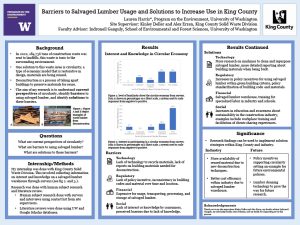FINDING BARRIERS TO USING SALVAGED LUMBER AND SOLUTIONS TO INCREASE USE IN KING COUNTY
There is a lot of construction waste that goes into landfills; the construction industry produces about 15% of materials brought to site as waste (Akinade 2020). There are a lot of available materials that are wasted and could be reused, one of these types of materials is salvaged lumber. The aim of this study is to understand barriers to using salvaged lumber and finding solutions to these barriers for the aim of increasing use of salvaged lumber. Research was done by combining human subject research and a literature review; human subject research consisted of a survey and interviews contacted using a subject list provided by the GreenTools Division of the King County Solid Waste Division. Subjects were contacted using email and LinkedIn, surveys were conducted using Qualtrics, interviews were conducted on zoom. Findings show that the most significant barriers to using salvaged lumber fall into the following major categories: technology, regulatory, financial, and social. Solutions were found to address each barrier; some examples include better records of building construction, salvaged lumber warehouses to cut costs of processing and transportation, training to increase expertise, and increases in education about circularity. With more knowledge and ability to use salvaged lumber; there are implications for decreasing construction waste and increasing efficiency in materials used in the built environment, as well as increases in knowledge on sustainability.
